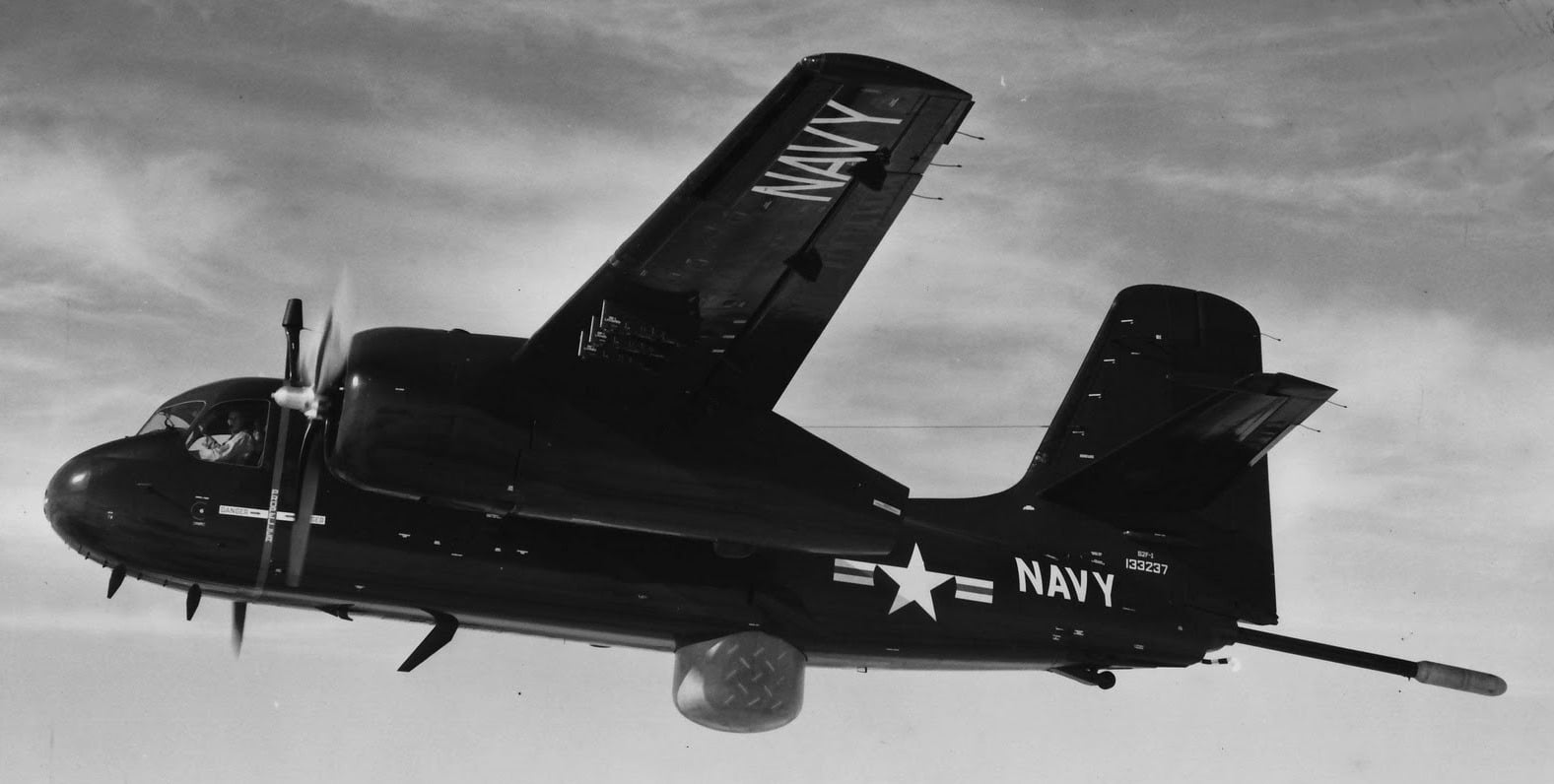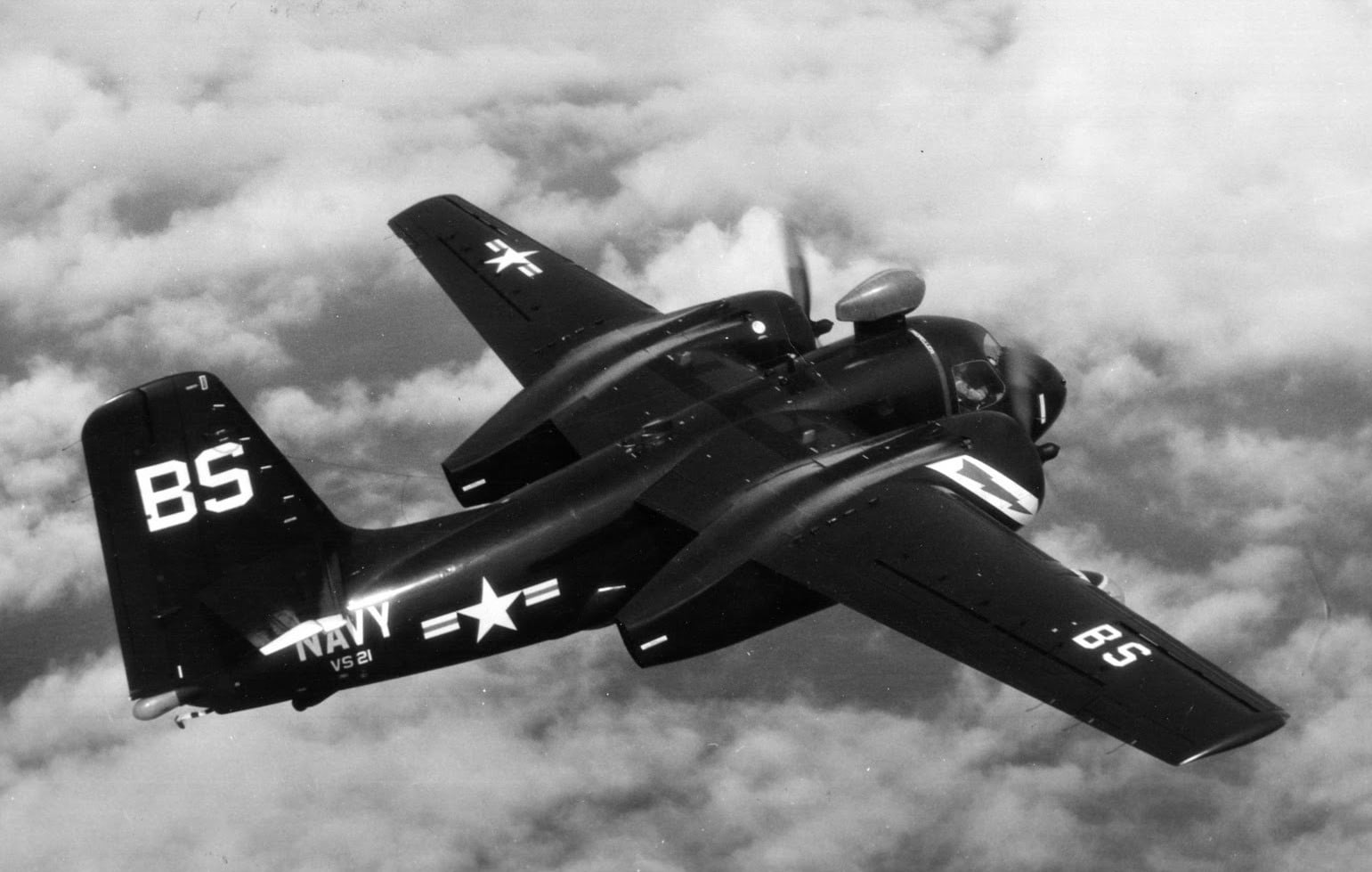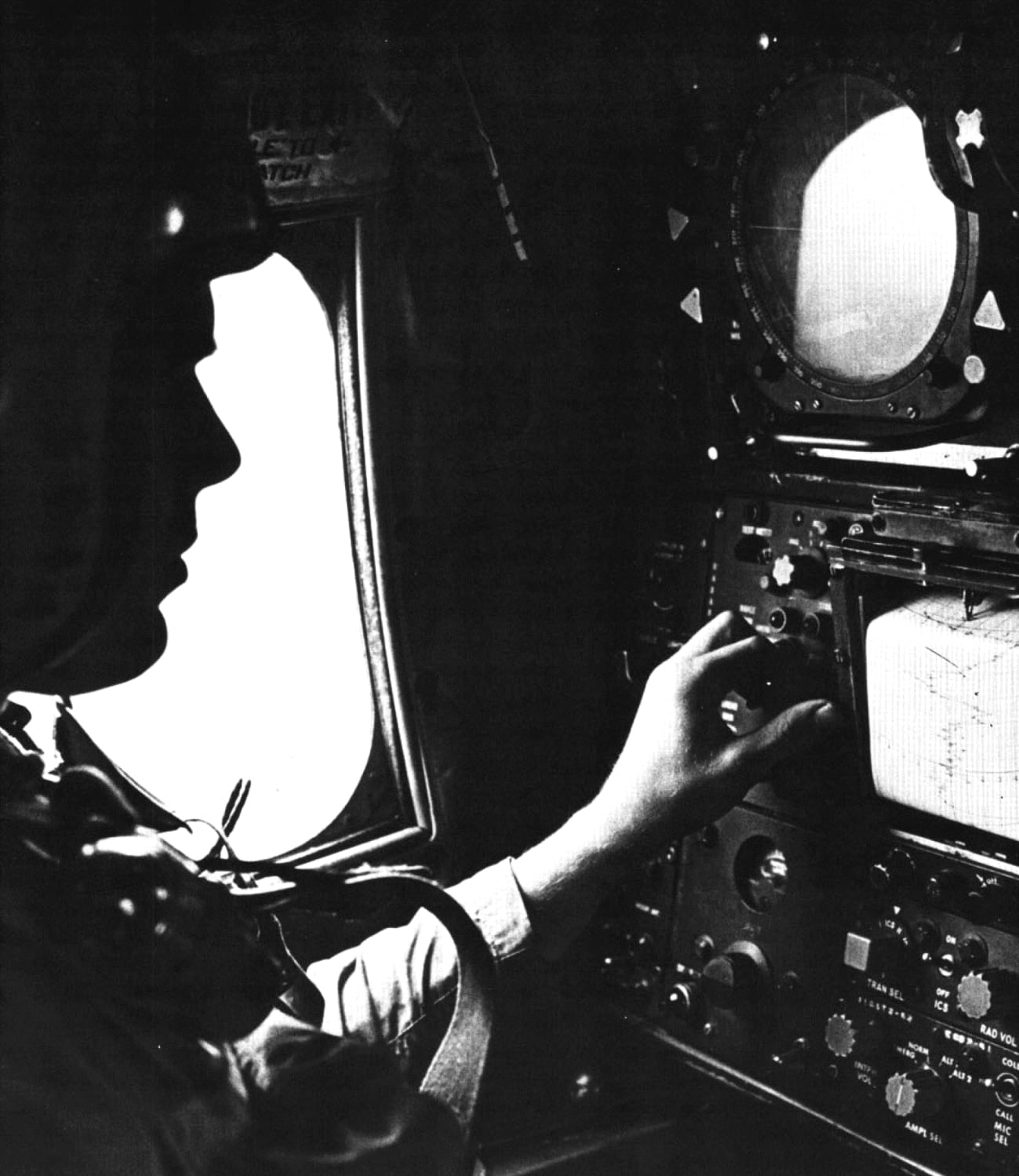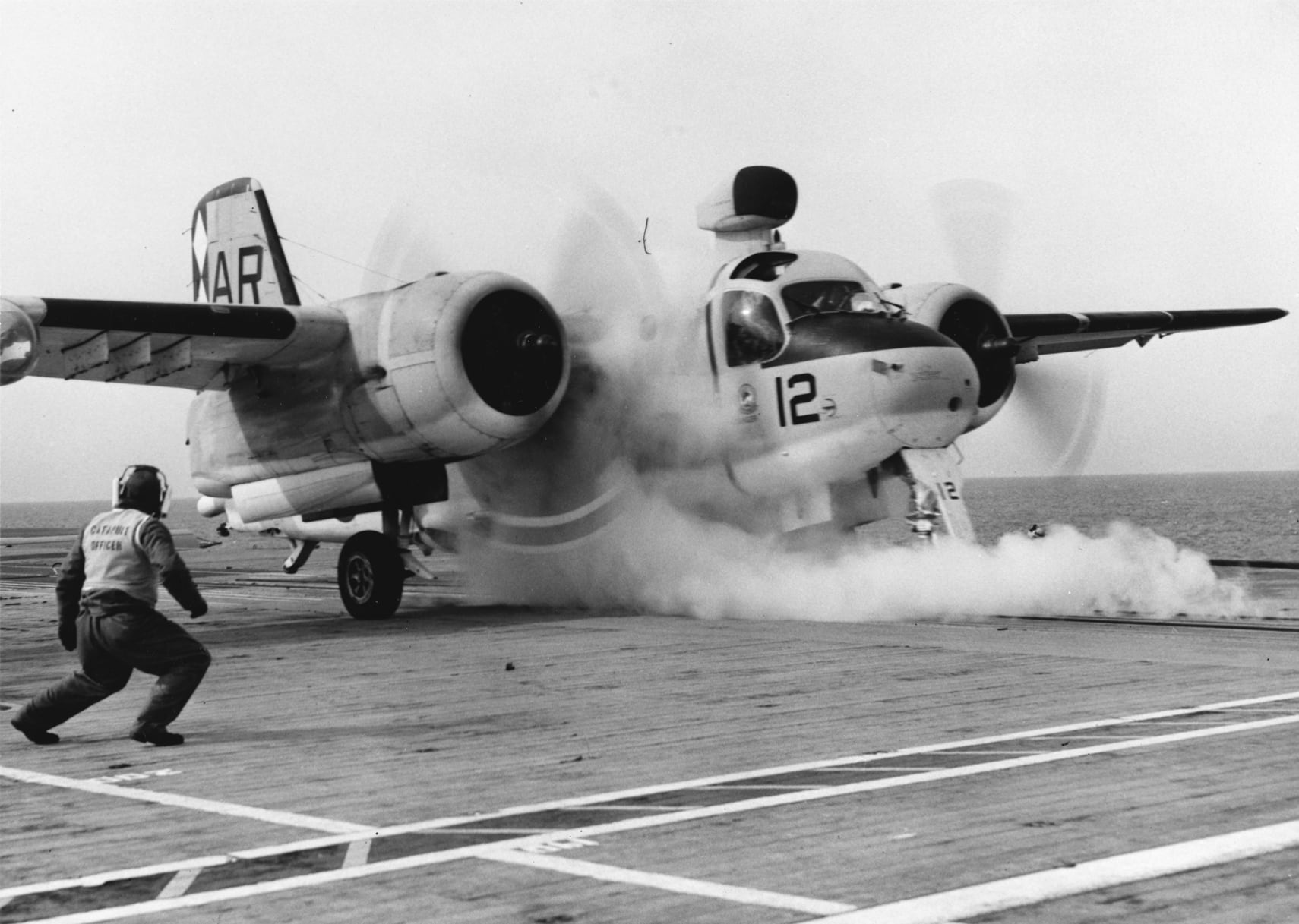The Navy’s Versatile Tracker Did It All, All Over The World, For 32 Very Hot Cold War Years
The Grumman S2F-1 (later S-2) Tracker entered United States Navy (USN) service with VS-26 Ready Squadron in February 1954. Stoofs would go on to serve with the USN for 32 years, and are only now being replaced by some foreign operators today. The basic airframe would be adapted to create an airborne early warning version (the WF-2 or Willie Fudd; after 1962, the E-1B Tracer or Stoof With a Roof) and the C-1A Trader (simply the COD for Carrier Onboard Delivery). The focus of this retrospective will be the anti-submarine warfare (ASW) version of the legendary Stoof.

Replacing Two Aircraft With One
When Grumman began drawing the S2F-1, they were in effect replacing their own previous AF Guardian design- the first purpose-built carrier-based antisubmarine warfare aircraft. The Guardian “system” was actually two aircraft- one to detect and localize contacts using several types of detection equipment (the AF-2W “hunter”), and another aircraft equipped with weapons systems to attack contacts (the AF-2S “killer”). Grumman’s new dedicated carrier-based antisubmarine aircraft would combine both hunter and killer roles into a single airframe.

A Grumman Design All the Way
Grumman’s G-89 design was conventional, simple, and ruggedly built. Powered by a pair of Wright R-1820 Cyclone radial piston engines, the design featured high-mounted, high-aspect wings spanning more than 72 feet that folded nearly flat over the fuselage for storage onboard aircraft carriers.
The aircraft also featured tricycle landing gear with a stout tail wheel, designed for use when launching via catapult, and a crew of four. The Navy’s Bureau of Aeronautics (BuAer) ordered two prototype XS2F-1 and 15 production S2F-1 aircraft simultaneously at the end of June 1950.

Sensors We Still Use Today
The Stoof first took to the skies on 4 December 1952. To detect and localize targets, the S2F was equipped with the three tools every antisubmarine aircraft had to have then (and really still do): Radar, Sonar, and MAD. The radar was the Philco/Ford AN/APS-38 X-band system ventrally mounted in a retractable radome.
The non-acoustic sensor operator was seated on the port side of the crew compartment. Sonar was facilitated by passive and active sonobuoys, which were released from the rear of both engine nacelles. Signals from the sonobuoys were received at the acoustic sensor operator’s station on the starboard side of the crew compartment.

MADMAN! MADMAN! MADMAN! Smoke Away!
The AN/ASQ-8 Magnetic Anomaly Detector (MAD) was mounted at the end of a retractable boom that extended from the extreme aft end of the fuselage below the rudder. The early Stoof variants also had a radome mounted on top of the fuselage forward, just behind the cockpit housing Electronic Surveillance Measures (ESM) equipment. Also mounted in the ESM radome was a particle detector (or sniffer) capable of detecting diesel fuel exhaust particles. A 70 million candlepower searchlight was mounted on the starboard wing. The Stoof was also equipped with smoke marker dispensers for visual MAD datum tracking.

Warshots For Soviet Targets
To attack and “kill” their targets, operational Trackers were capable of carrying two Mark 34, Mark 41, Mark 43, Mark 44, or Mark 46 lightweight torpedoes or one Mark 90 nuclear depth charge in their 4,800-pound capacity internal bomb bays. Under the outer wing panels, six underwing hard points could also carry conventional Mark 54 depth charges, unguided high-velocity aircraft rocket (HVAR) or Zuni rocket pods, or four more lightweight torpedoes. Later Tracker variants could also carry AGM-12 Bullpup air-to-ground missiles.

Continuously Improving the Stoof
As S2Fs served over the years, they were upgraded and improved. The ESM ventral radome was removed, and the sensors were relocated to rounded wingtip housings. The engine nacelles were modified to allow carriage of additional sonobuoys (too many of which no sensor operator [or senso] could possibly have).
As sonobuoys, their associated receivers, and other detection and localization equipment improved, those improvements were integrated into the Tracker fleet. In 1962, when the entire aircraft designation system was revised, the S2F-1 Trackers were redesignated as the S-2A Trackers. And so on…

What Couldn’t the Tracker Do?
Trackers were also adapted for other roles. S2F-1T/TS-2A Trackers served as multi-engine trainers. S2F-1U/US-2A (and later US-2B, US-2C, and US-2F) Trackers had their ASW mission equipment removed and seats installed in their place. The Marines even operated a few US-2As and US-2Bs. The S2F-2P/RS-2C was a single photo reconnaissance version of the Tracker.
Beginning with the S2F-3/S-2D, the Tracker received a fuselage extension just aft of the cockpit, larger tail surfaces, increased fuel capacity, and those modified engine nacelles. The S2F-3S/S-2E received improved detection equipment. When the Navy needed an electronic warfare trainer aircraft, the WS-2D filled the role. The S-2G was the last ASW version of the Tracker, derived from improved previous-build S-2Es.


My summer home is Prescott, Arizona, where we have experienced several brush/forest fires. What a joy to see the Stoof retrofitted with turboprops flying overhead on its way to a fire!
I was a TACCO in VP-49 (Marlin 2 and Orion) and then served at NATC PAXRIV, where I sat in the right seat in several Stoof test flights. Beautiful bird!
I’ve read that Grumman designed a carrier-based Fleet Air Defence (FAD) submission to 1959 USN Technical Speculation 151 (TS-151) Fleet Air Defence (FAD) aircraft – aka Missileer, which itself was a derivative of the WF-2/E-1 Tracer.
This design was known as the Bendix-Grumman BSD160 – aka Grumman Design 123-F
The Design 123-F design incorporated the following:
– Powered by two turboprop engines;
– a fuselage weapons bay which accommodated six 100 miles (160 km) range Bendix AAM-M-10 Eagle long-range AAM’s;
– a powerful long-range Westinghouse AN/APQ-81 radar;
– A dedicated missile operator console.